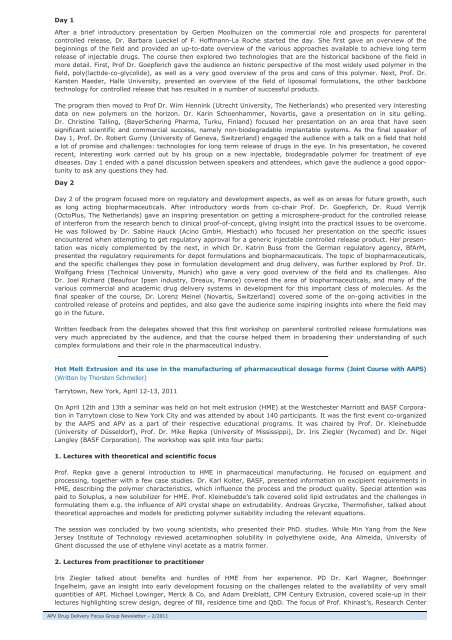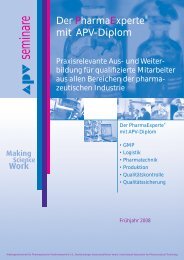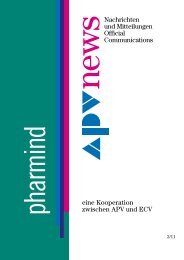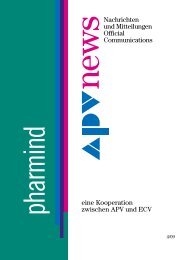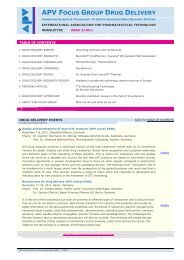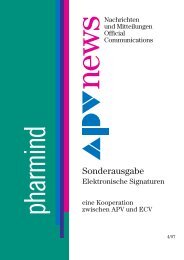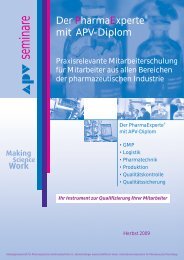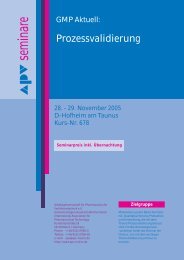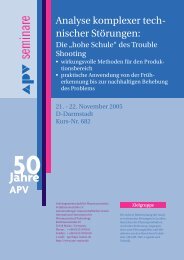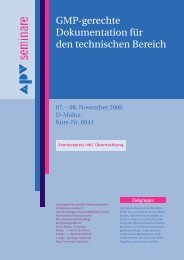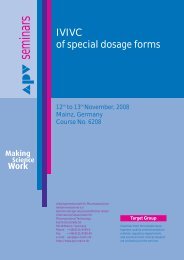APV FOCUS GROUP DRUG DELIVERY
APV FOCUS GROUP DRUG DELIVERY
APV FOCUS GROUP DRUG DELIVERY
You also want an ePaper? Increase the reach of your titles
YUMPU automatically turns print PDFs into web optimized ePapers that Google loves.
Day 1<br />
After a brief introductory presentation by Gerben Moolhuizen on the commercial role and prospects for parenteral<br />
controlled release, Dr. Barbara Lueckel of F. Hoffmann-La Roche started the day. She first gave an overview of the<br />
beginnings of the field and provided an up-to-date overview of the various approaches available to achieve long term<br />
release of injectable drugs. The course then explored two technologies that are the historical backbone of the field in<br />
more detail. First, Prof Dr. Goepferich gave the audience an historic perspective of the most widely used polymer in the<br />
field, poly(lactide-co-glycolide), as well as a very good overview of the pros and cons of this polymer. Next, Prof. Dr.<br />
Karsten Maeder, Halle University, presented an overview of the field of liposomal formulations, the other backbone<br />
technology for controlled release that has resulted in a number of successful products.<br />
The program then moved to Prof Dr. Wim Hennink (Utrecht University, The Netherlands) who presented very interesting<br />
data on new polymers on the horizon. Dr. Karin Schoenhammer, Novartis, gave a presentation on in situ gelling.<br />
Dr. Christine Talling, (BayerSchering Pharma, Turku, Finland) focused her presentation on an area that have seen<br />
significant scientific and commercial success, namely non-biodegradable implantable systems. As the final speaker of<br />
Day 1, Prof. Dr. Robert Gurny (University of Geneva, Switzerland) engaged the audience with a talk on a field that hold<br />
a lot of promise and challenges: technologies for long term release of drugs in the eye. In his presentation, he covered<br />
recent, interesting work carried out by his group on a new injectable, biodegradable polymer for treatment of eye<br />
diseases. Day 1 ended with a panel discussion between speakers and attendees, which gave the audience a good opportunity<br />
to ask any questions they had.<br />
Day 2<br />
Day 2 of the program focused more on regulatory and development aspects, as well as on areas for future growth, such<br />
as long acting biopharmaceuticals. After introductory words from co-chair Prof. Dr. Goepferich, Dr. Ruud Verrijk<br />
(OctoPlus, The Netherlands) gave an inspiring presentation on getting a microsphere-product for the controlled release<br />
of interferon from the research bench to clinical proof-of-concept, giving insight into the practical issues to be overcome.<br />
He was followed by Dr. Sabine Hauck (Acino GmbH, Miesbach) who focused her presentation on the specific issues<br />
encountered when attempting to get regulatory approval for a generic injectable controlled release product. Her presentation<br />
was nicely complemented by the next, in which Dr. Katrin Buss from the German regulatory agency, BfArM,<br />
presented the regulatory requirements for depot formulations and biopharmaceuticals. The topic of biopharmaceuticals,<br />
and the specific challenges they pose in formulation development and drug delivery, was further explored by Prof. Dr.<br />
Wolfgang Friess (Technical University, Munich) who gave a very good overview of the field and its challenges. Also<br />
Dr. Joel Richard (Beaufour Ipsen industry, Dreaux, France) covered the area of biopharmaceuticals, and many of the<br />
various commercial and academic drug delivery systems in development for this important class of molecules. As the<br />
final speaker of the course, Dr. Lorenz Meinel (Novartis, Switzerland) covered some of the on-going activities in the<br />
controlled release of proteins and peptides, and also gave the audience some inspiring insights into where the field may<br />
go in the future.<br />
Written feedback from the delegates showed that this first workshop on parenteral controlled release formulations was<br />
very much appreciated by the audience, and that the course helped them in broadening their understanding of such<br />
complex formulations and their role in the pharmaceutical industry.<br />
Hot Melt Extrusion and its use in the manufacturing of pharmaceutical dosage forms (Joint Course with AAPS)<br />
(Written by Thorsten Schmeller)<br />
Tarrytown, New York, April 12-13, 2011<br />
On April 12th and 13th a seminar was held on hot melt extrusion (HME) at the Westchester Marriott and BASF Corporation<br />
in Tarrytown close to New York City and was attended by about 140 participants. It was the first event co-organized<br />
by the AAPS and <strong>APV</strong> as a part of their respective educational programs. It was chaired by Prof. Dr. Kleinebudde<br />
(University of Düsseldorf), Prof. Dr. Mike Repka (University of Mississippi), Dr. Iris Ziegler (Nycomed) and Dr. Nigel<br />
Langley (BASF Corporation). The workshop was split into four parts:<br />
1. Lectures with theoretical and scientific focus<br />
Prof. Repka gave a general introduction to HME in pharmaceutical manufacturing. He focused on equipment and<br />
processing, together with a few case studies. Dr. Karl Kolter, BASF, presented information on excipient requirements in<br />
HME, describing the polymer characteristics, which influence the process and the product quality. Special attention was<br />
paid to Soluplus, a new solubilizer for HME. Prof. Kleinebudde’s talk covered solid lipid extrudates and the challenges in<br />
formulating them e.g. the influence of API crystal shape on extrudability. Andreas Gryczke, Thermofisher, talked about<br />
theoretical approaches and models for predicting polymer suitability including the relevant equations.<br />
The session was concluded by two young scientists, who presented their PhD. studies. While Min Yang from the New<br />
Jersey Institute of Technology reviewed acetaminophen solubility in polyethylene oxide, Ana Almeida, University of<br />
Ghent discussed the use of ethylene vinyl acetate as a matrix former.<br />
2. Lectures from practitioner to practitioner<br />
Iris Ziegler talked about benefits and hurdles of HME from her experience. PD Dr. Karl Wagner, Boehringer<br />
Ingelheim, gave an insight into early development focusing on the challenges related to the availability of very small<br />
quantities of API. Michael Lowinger, Merck & Co, and Adam Dreiblatt, CPM Century Extrusion, covered scale-up in their<br />
lectures highlighting screw design, degree of fill, residence time and QbD. The focus of Prof. Khinast’s, Research Center<br />
<strong>APV</strong> Drug Delivery Focus Group Newsletter – 2/2011 Page 2 of 15


